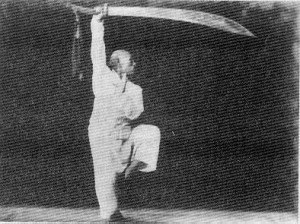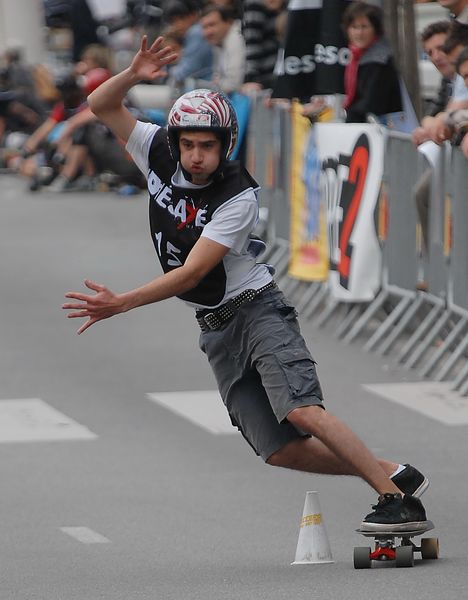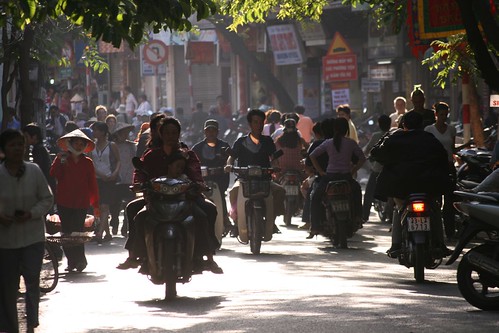Yi
/ In the Early 90's when George Xu came back from judging a tournament on the East Coast, he told us that he had been in an interesting and friendly argument with Nan Lu, a baguazhang practitioner in New York City.
In the Early 90's when George Xu came back from judging a tournament on the East Coast, he told us that he had been in an interesting and friendly argument with Nan Lu, a baguazhang practitioner in New York City.The argument was over how to describe high level Yi. Yi is most often translated "intension," but the English word doesn't do it justice. Some modern Qi jocks now use the word Yinian, generally meaning something more like "mind" but in qigong circles it simply refers to "the pathway along which you intend to send qi."
When George Xu wanted to explain to a beginning student what yi was, he would describe two Doberman-pinchers. Both were told to charge at a group of people. One dog got up close and hesitated, jumping around and barking, not sure who to bite. The other dog, the one with clear yi, immediately bit the neck of the guy with the blue shirt.
George had been arguing that one should train with "killer" yi, the mind should be focused exactly on how to kill the opponent. Nan Lu was arguing that one should have "zero" yi, a mind like a translucent sky. George wasn't willing to concede but he thought Nan Lu's argument had merit.
 A more common use of the word Yi, one that nearly all Chinese martial arts teachers use, means to have an awareness of technique. A student has yi in his form when a knowledgeable observer can see the fighting idea in the students movement. Numerous throws, joint breaks, and striking combination possibilities should be apparent.
A more common use of the word Yi, one that nearly all Chinese martial arts teachers use, means to have an awareness of technique. A student has yi in his form when a knowledgeable observer can see the fighting idea in the students movement. Numerous throws, joint breaks, and striking combination possibilities should be apparent.Every technique must have the correct force trajectories, and these must be practiced on a live partner. These trajectories themselves are also called yi. Martial arts techniques use trajectories which are vectors, arcs, and spirals. All of this is referred to as yi.
One of the magical things about a gongfu form or routine is that because the same movement can be used for many different techniques, a seasoned practitioner will develop more and more complex yi as the years go by. A single movement can have a hundred different expressions.
This seasoned and complex yi at some point starts to look less specific. With very clear yi, it looks like I'm making an upper-cut to the chin. But if I've thoroughly trained 15 different techniques for that movement I can do the movement in what we might call an undifferentiated potential state. Instead of a specific technique or fighting idea showing itself, the yi starts to look like clouds swirling around the body. It is not that you actually see the clouds, what you see is all the possibilities at once.
 Practicing at this yi level also feels like clouds, or sometimes like water, fire or mist. Once a practitioner reaches this level, she stops thinking in terms of techniques.
Practicing at this yi level also feels like clouds, or sometimes like water, fire or mist. Once a practitioner reaches this level, she stops thinking in terms of techniques.Kumar Frantzis said about Xingyi that when you strike you should be thinking "Only One Thing."
A Samurai by the old code (budo) didn't need technique, he needed only to be willing to die.
Wang Xiangzhai, one of the greatest internal martial artists of the 20th Century, said that "the yi should always be round." I'm working on it.

 I just wanted to throw this term out into cyberspace and see if anyone is interested in discussing what it means.
I just wanted to throw this term out into cyberspace and see if anyone is interested in discussing what it means. Whenever I size someone up, of course I look at the usual stuff: their alignment, do they look weak in some areas and stronger in others? what kind of reach do they have? but the big question is, could they do something to me that would hurt more than falling off my skateboard at 30 miles an hour onto the pavement and then sliding to a stop?
Whenever I size someone up, of course I look at the usual stuff: their alignment, do they look weak in some areas and stronger in others? what kind of reach do they have? but the big question is, could they do something to me that would hurt more than falling off my skateboard at 30 miles an hour onto the pavement and then sliding to a stop? hill it looks like he or she is leaning forward and back. Actually what happens is the instant one moves their weight to one side of the board, the board starts turning to come underneath the weight. This creates first a feeling of heaviness as your weight goes into the board, and then a feeling of lightness as your forward momentum takes you over to the other side of the board. As your weight crosses the centerline you feel weightless for a moment and then you come down heavy on the other side of the board as it turns again.
hill it looks like he or she is leaning forward and back. Actually what happens is the instant one moves their weight to one side of the board, the board starts turning to come underneath the weight. This creates first a feeling of heaviness as your weight goes into the board, and then a feeling of lightness as your forward momentum takes you over to the other side of the board. As your weight crosses the centerline you feel weightless for a moment and then you come down heavy on the other side of the board as it turns again. You know that feeling you get when you spin around really fast and then stop? In the cartoons this feeling is usually illustrated with a swirl and some stars around the head. But actually the whole body has this spinning feeling. You can feel it in your knees and elbows too.
You know that feeling you get when you spin around really fast and then stop? In the cartoons this feeling is usually illustrated with a swirl and some stars around the head. But actually the whole body has this spinning feeling. You can feel it in your knees and elbows too. Just a simple image for today.
Just a simple image for today.

 Processions for popular Heavenly gods mimicked the parading that magistrates and other representatives of Earthly government employed. In one account, Sutton describes how a magistrate and his entourage are forced to wait for some offensive amount of time while a god (often a youth with a painted face) passes by in a sedan chair dressed in magistrate like robes with a simular but perhaps larger entourage.
Processions for popular Heavenly gods mimicked the parading that magistrates and other representatives of Earthly government employed. In one account, Sutton describes how a magistrate and his entourage are forced to wait for some offensive amount of time while a god (often a youth with a painted face) passes by in a sedan chair dressed in magistrate like robes with a simular but perhaps larger entourage. Thus confessions were associated with both healing and merit. The threat of torture in the near future or by
Thus confessions were associated with both healing and merit. The threat of torture in the near future or by  Aggression, of course, is a constant "cause" of qi wasting. From a Daoist point of view, if you lose your temper, you probably caused yourself a very minor internal injury, but you also caused some kind of reaction in the world around you. That reaction, like a ripple in a pond might dissipate gently, but it also might lead to a tidal wave somewhere down the line. And since we have no way of really knowing, losing your temper is seen as inappropriate. I think it is important to note, that from a Daoist point of view, well timed aggression may be worth the risk.
Aggression, of course, is a constant "cause" of qi wasting. From a Daoist point of view, if you lose your temper, you probably caused yourself a very minor internal injury, but you also caused some kind of reaction in the world around you. That reaction, like a ripple in a pond might dissipate gently, but it also might lead to a tidal wave somewhere down the line. And since we have no way of really knowing, losing your temper is seen as inappropriate. I think it is important to note, that from a Daoist point of view, well timed aggression may be worth the risk. Then there is the corner of medicine and elite scholarly exchange which merges in to the much larger realm of commerce.
Then there is the corner of medicine and elite scholarly exchange which merges in to the much larger realm of commerce. The word orthodox is pretty common. It means a right way of thinking or a correct standard way of understanding.
The word orthodox is pretty common. It means a right way of thinking or a correct standard way of understanding.